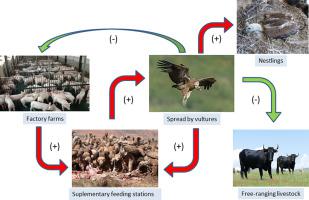Science of the Total Environment ( IF 8.2 ) Pub Date : 2020-11-21 , DOI: 10.1016/j.scitotenv.2020.143681 Guillermo Blanco , Juan A. Díaz de Tuesta

|
Livestock production is a large source of microbial, pharmaceutical, and antimicrobial pollution worldwide. Vultures are one group of birds with particularly high exposure to food-borne pathogens due to frequent consumption of infected livestock carcasses. The potential origin and spatial-temporal shedding patterns of livestock-adapted Salmonella serotypes of zoonotic importance were evaluated in adult and nestling Griffon vultures (Gyps fulvus). We specifically assessed the exposure source and subsequent elimination of Salmonella-infected carcasses (ecosystem services) or transmission back to livestock (ecosystem disservices) by vultures, thus contributing respectively to disease mitigation or amplification in natural and farmed environments. The results show a seasonal high occurrence and turnover of a high variety of serotypes, especially swine-adapted ones isolated at high frequency. This suggests that vultures can be reservoirs and long-distance carriers of faecal Salmonella shed in supplementary feeding stations and breeding colonies. Contrary to their conservation purposes, feeding stations can act as Salmonella hotspots and reservoirs. However, a role for vultures in the transmission back to food-producing animals seems impossible because they do not come into contact at indoor farms, while transmission to free-ranging ruminants was not supported by the presence of ruminant-adapted serotypes in the vultures. Therefore, vultures do not promote disservices associated with the re-infection of livestock with Salmonella, but can provide quantitatively important ecosystem services by removing carrion contaminated with these and other zoonotic pathogens potentially affecting their health. Sanitary vigilance of the farms authorised to provide food for avian scavengers should avoid the disposal of swine and poultry carcasses with Salmonella and the antibiotics used to treat it. Extensive free-ranging livestock and their carcasses exploited in the countryside should be a priority for the conservation of vultures and their ecological function as cleaners and disease mitigators.
中文翻译:

农田环境中狮riff秃zoo的人畜共患沙门氏菌血清型的季节性和空间分布:对病原体污染以及生态系统服务和损害的影响
畜牧生产是全世界微生物,药物和抗菌素污染的主要来源。秃鹰是一组鸟类,由于经常食用被感染的牲畜尸体,它们尤其容易暴露于食源性病原体。在成年和雏鸟格里芬秃鹰(Gyps fulvus)中评估了具有人畜共患意义的适应牲畜的沙门氏菌血清型的潜在起源和时空脱落模式。我们专门评估了暴露源并随后消除了沙门氏菌-car体感染(生态系统服务)或通过秃transmission传播回牲畜(生态系统损害),因此分别有助于减轻自然环境或养殖环境中的疾病或使其疾病扩大。结果表明,季节性高发和大量血清型的转换,特别是高频率分离的猪适应型。这表明秃鹰可能是粪便沙门氏菌在辅助饲养站和繁殖菌落中的蓄水池和远距离携带者。与保护目的相反,饲养站可以充当沙门氏菌热点和水库。但是,秃v在传播回食用动物中的作用似乎是不可能的,因为它们不会在室内农场接触,而秃free中存在反刍动物适应型血清型则不能支持向自由放养的反刍动物的传播。因此,秃鹰不会促进与沙门氏菌再感染牲畜有关的危害,但是可以通过去除被这些沙门氏菌和其他人畜共患病原体污染的腐肉提供潜在的重要生态系统服务。被授权为禽类清道夫提供食物的农场应保持警惕,避免与沙门氏菌一起处理猪和家禽尸体以及用来治疗它的抗生素。在农村地区开发的广泛放养的牲畜及其尸体应作为保护秃鹰及其作为清洁剂和缓解疾病的生态功能的优先事项。











































 京公网安备 11010802027423号
京公网安备 11010802027423号